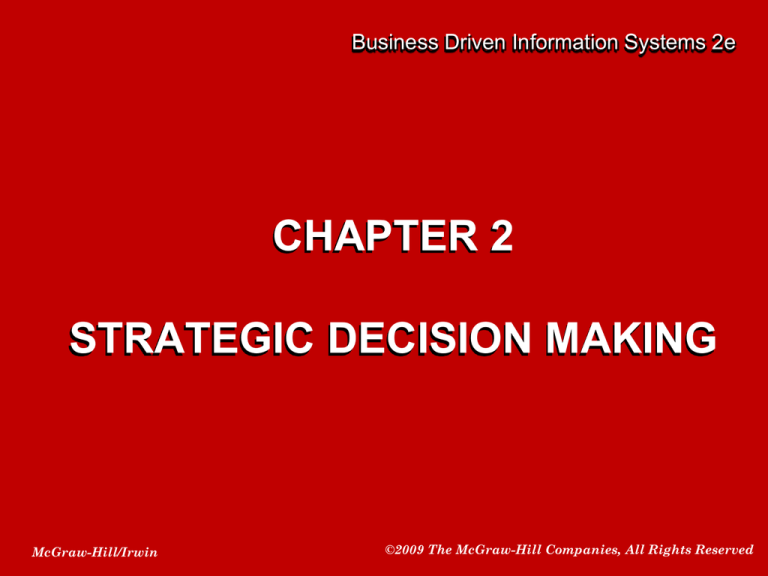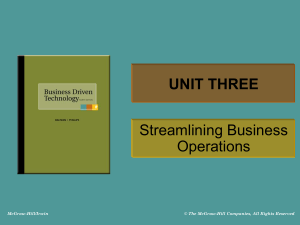
Business Driven Information Systems 2e
CHAPTER 2
STRATEGIC DECISION MAKING
McGraw-Hill/Irwin
©2009 The McGraw-Hill Companies, All Rights Reserved
SECTION 2.1
DECISION-MAKING
SYSTEMS
McGraw-Hill/Irwin
©2009 The McGraw-Hill Companies, All Rights Reserved
2-3
DECISION MAKING
• People must:
– Analyze large amounts of information
– Make decisions quickly
– Apply sophisticated analysis techniques
• Systems support these activities
2-4
DECISION MAKING
• IT systems in
an enterprise
2-5
TRANSACTION PROCESSING
SYSTEMS
2-6
TRANSACTION PROCESSING
SYSTEMS
• Transaction processing system (TPS) - basic
business system that serves the operational level
• Online transaction processing (OLTP) – capturing
of transaction and event information using
technology
• Online analytical processing (OLAP) –
manipulation of information to create business
intelligence in support of strategic decision making
2-7
DECISION SUPPORT SYSTEMS
• Decision support system (DSS) – models
information to support managers and business
professionals during the decision-making process
• Three quantitative models used by DSSs include:
1. Sensitivity analysis
2. What-if analysis
3. Goal-seeking analysis
2-8
EXECUTIVE INFORMATION SYSTEMS
•
Executive information system (EIS) – a
specialized DSS that supports senior level
executives within the organization
•
Most EISs offering the following capabilities:
– Consolidation
– Drill-down
– Slice-and-dice
2-9
EXECUTIVE INFORMATION SYSTEMS
2-10
Digital Dashboards
2-11
ARTIFICIAL INTELLIGENCE (AI)
• Intelligent system – various commercial
applications of artificial intelligence
• Artificial intelligence (AI) – simulates
human intelligence such as the ability to
reason and learn
2-12
ARTIFICIAL INTELLIGENCE (AI)
•
Four most common categories of AI include:
1. Expert system
2. Neural Network
– Fuzzy logic
3. Genetic algorithm
4. Intelligent agent
2-13
Data Mining
• Data-mining systems sift instantly through
information to uncover patterns and
relationships
• Data-mining systems include many forms
of AI such as neural networks and expert
systems
SECTION 2.2
BUSINESS PROCESSES
McGraw-Hill/Irwin
©2009 The McGraw-Hill Companies, All Rights Reserved
2-15
UNDERSTANDING THE IMPORTANCE OF
BUSINESS PROCESS
• Business process – a standardized set of
activities that accomplish a specific task
– Customer facing process
– Business facing process
2-16
BUSINESS PROCESS
IMPROVEMENT
• Business process improvement – attempts to
understand and measure the current process
and make performance improvements
accordingly
2-17
BUSINESS PROCESS REENGINEERING
• Business process reengineering (BPR) analysis and redesign of workflow within and
between enterprises
2-18
Finding Opportunity Using BPR
2-19
BUSINESS PROCESS
MODELING
• Business process modeling (or mapping) creating a detailed flow chart or process map of a
work process showing its inputs, tasks, and
activities, in a structured sequence
• Business process model - a graphic description
of a process, showing the sequence of process
tasks, which is developed for a specific
– As-Is process model
– To-Be process model
2-20
BUSINESS PROCESS
MODELING
2-21
BUSINESS PROCESS
MANAGEMENT
• Business process management (BPM) - integrates all of
an organization’s business process to make individual
processes more efficient
2-22
BPM Examples
2-23
BPM Examples







